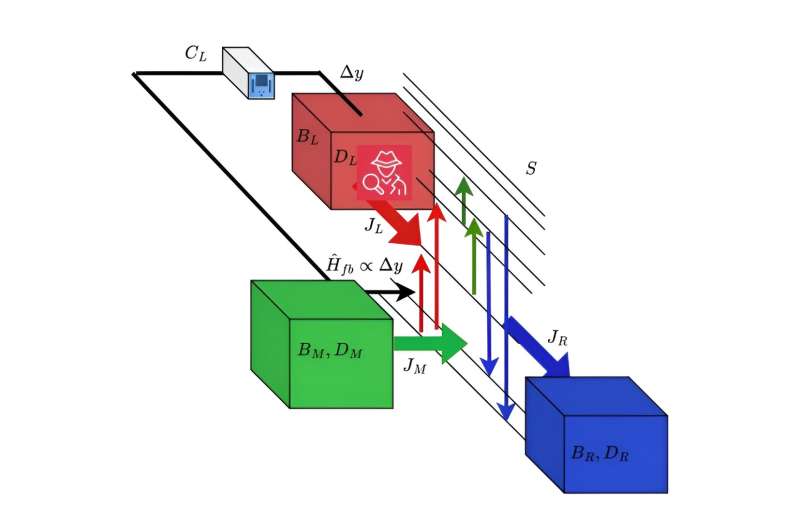
OCTOBER 7, 2024 by Uthpala N. Ekanayake and Malin Premaratne
Collected at: https://phys.org/news/2024-10-quantum-thermal-transistors.html
Scientists are finding ways to use quantum effects to create groundbreaking thermal devices that can help cool electronic systems. The quantum thermal transistor is one of the most exciting innovations in this field. While the current works surrounding this device are still theoretical, recent advancements in the fabrication of qubits using quantum dots and superconducting circuits have created a growing sense of optimism.
These quantum thermal transistors use the unique principles of quantum mechanics, where heat transfer occurs in discrete jumps between energy levels—much like how quantum computers process information on a tiny scale.
Today’s quantum thermal transistor models operate with limited self-regulation, but our recent work at the Advanced Computing and Simulation Laboratory (AχL) at Monash University, Australia, in collaboration with the Jet Propulsion Laboratory at Caltech, introduces a new concept.
We propose a self-regulating quantum thermal transistor capable of controlling its performance using feedback mechanisms. Inspired by the idea of feedback resistors in traditional electronics, this feedback system helps reduce unwanted noise and interference (a phenomenon called decoherence), which often disrupts the delicate nature of quantum systems.
Our research is published in the journal APL Quantum.
What makes this so exciting?
Quantum thermal transistors could potentially maintain their quantum entanglement—a key feature that allows them to “communicate” with one another without the need for wires or physical connections, unlike classical transistors.
This opens the door to a completely new approach in electronics and cooling systems, where quantum devices may someday self-regulate, reducing the need for external controls.
The future: Smaller, cooler and smarter devices
As technology gets smaller and more powerful, one of the biggest challenges is dealing with the heat generated by these high-performance devices. In systems such as supercomputers, overheating can slow the performance or even cause failure. The feedback-enabled quantum thermal transistor could revolutionize thermal management by efficiently controlling heat while boosting the system’s functionality.
Though it might seem like something out of science fiction, a self-regulating quantum thermal transistor has real-world potential for managing energy more efficiently. With continued breakthroughs, the future of quantum thermal devices seems bright, and we may soon see this futuristic technology integrated into everyday systems.
This story is part of Science X Dialog, where researchers can report findings from their published research articles. Visit this page for information about Science X Dialog and how to participate.
More information: Uthpala N. Ekanayake et al, Improving quantum thermal transistors through feedback-controlled baths, APL Quantum (2024). DOI: 10.1063/5.0229630
Karl Joulain et al, Quantum Thermal Transistor, Physical Review Letters (2016). DOI: 10.1103/PhysRevLett.116.200601
Bios:
Uthpala N. Ekanayake earned her B.Sc. in electrical and electronic engineering (with first-class honors) from University of Peradeniya, Sri Lanka in 2019. Currently she is a PhD candidate and a member of the Advanced Computing and Simulations Laboratory at the Department of Electrical and Computer Systems Engineering, Monash University, Australia under the supervision of Prof. Malin Premaratne.
Sarath D. Gunapala received a Ph.D. degree in physics from the University of Pittsburgh, Pittsburgh, PA, USA, in 1986. In 1992, he joined NASA’s Jet Propulsion Laboratory, California Institute of Technology, Pasadena, CA, USA, where he is currently the Director of the Center for Infrared Photodetectors. He is also a Senior Research Scientist and a Principal Member of the Engineering Staff with the NASA Jet Propulsion Laboratory.
Malin Premaratne earned several degrees from the University of Melbourne, including a B.Sc. in mathematics, a B.E. in electrical and electronics engineering (with first-class honors), and a PhD in 1995, 1995, and 1998, respectively. Currently, he is a full professor at Monash University Clayton, Australia. His expertise centers on quantum device theory, simulation, and design, utilizing the principles of quantum electrodynamics.
Journal information: Physical Review Letters

Leave a Reply